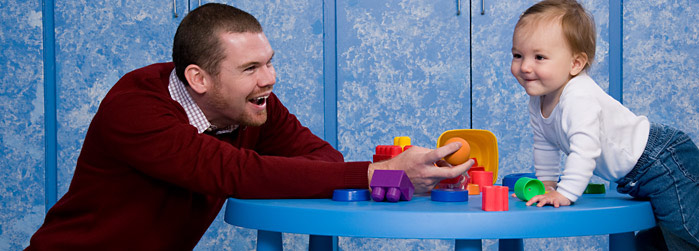
By observing how babies listen and respond to spoken language, we hope to unlock the mysteries of language learning!
We are looking for infants (ages 4 to 20 months), and their parents to participate in our language studies. We welcome all infants, whether they are learning one language at home or more!
Our studies take place at the University of Ottawa in a cozy, welcoming environment or online over Zoom in the comfort of your own home. Studies usually take half an hour to an hour, are scheduled at your convenience, and parking is free. Plus, we have special gifts for our participants!!!
We'd also love to answer any questions you might have on language development!
The Language Development Lab runs under the direction of Dr. Christopher Fennell. Our research team is composed of fourth-year honours students, graduate students, volunteers, and research assistants. All of our members are enthusiastic about early language acquisition and enjoy working with young children. To learn more about us, please take a look around the rest of our website!
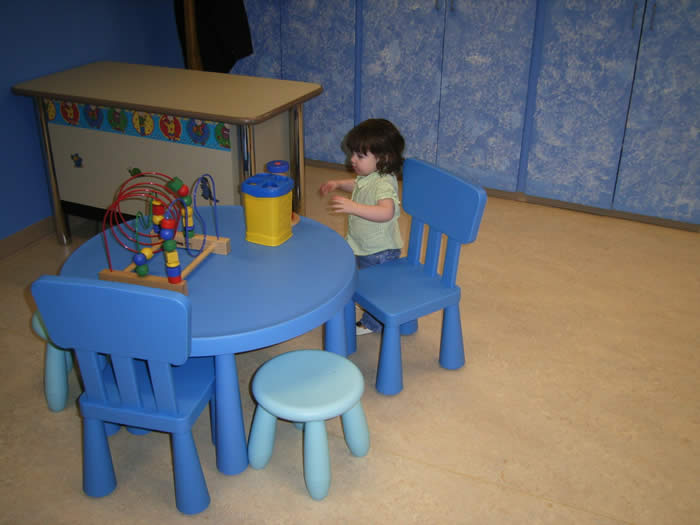
Virtual Tour of the Lab
You’ve set up an appointment, and after days of breathless anticipation the time has finally come: today is you & your baby’s session at the Language Development Lab.
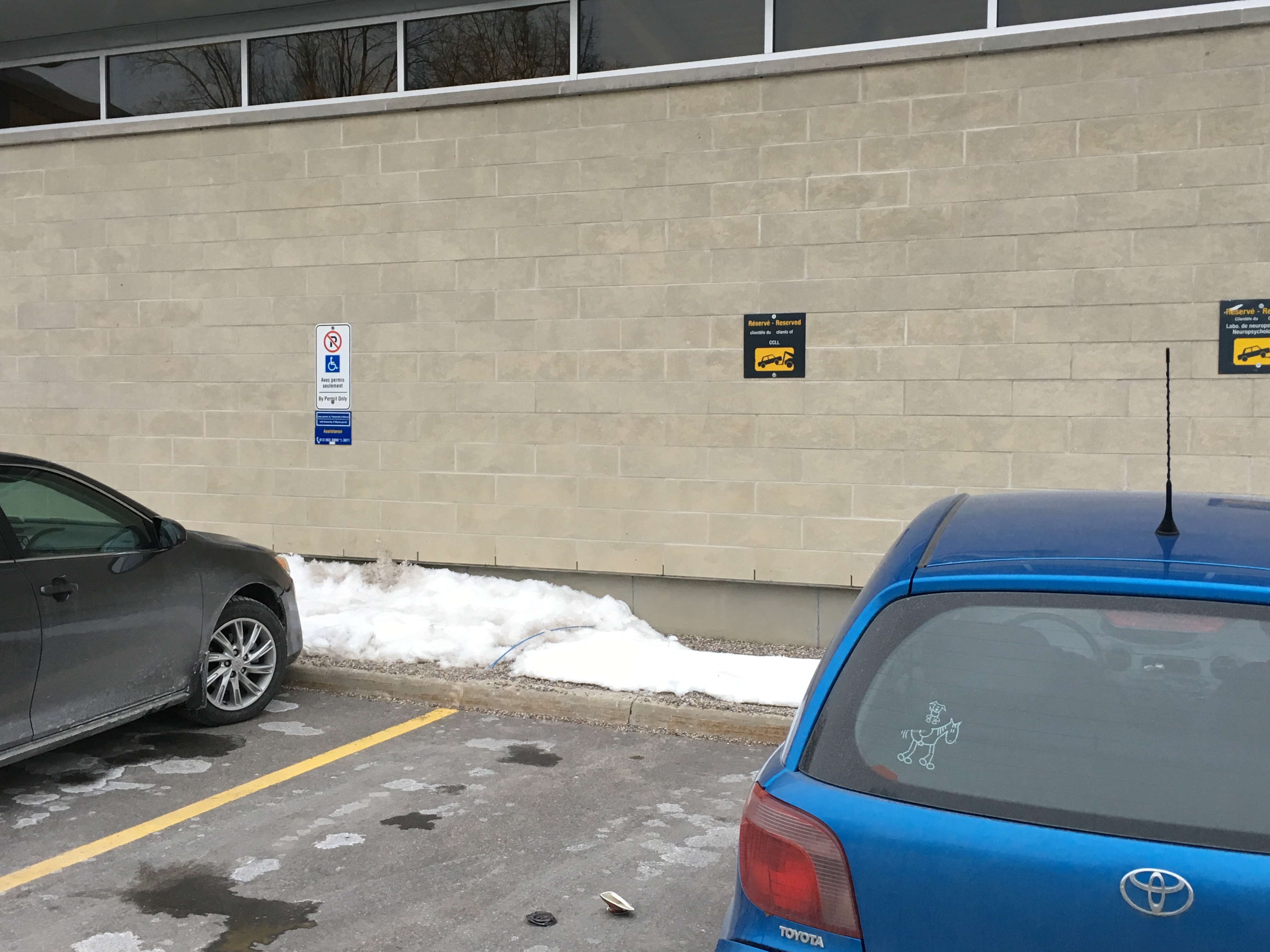
Turn onto Marie Curie Private. At the first stop sign turn left on to Louis Pasteur. Proceed down to the parking lot and turn right at the first opportunity. There will be three reserved parking spots on your right beside the handicap parking spots. Pull into the parking spot labelled CCLL. A research assistant will meet you there with the parking pass. You can also easily access the building by bus, as the Vanier building is right beside the transitway (Campus Station).

If you are walking or taking the bus, a smiling research assistant will meet you in the Main Entrance to the Vanier building.
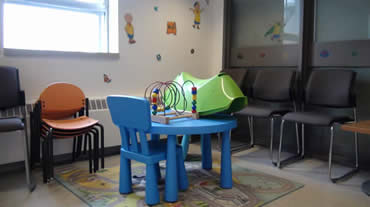
We will escort you up to 6012, which is our nice reception room. We have lots of cool toys for babies and kids to play with. We know they’re cool because we play with them ourselves when no one else is here.

After you and your baby have settled in, we will explain the study in detail to you. After we’ve explained everything and you’ve had a chance to ask questions, we’ll give you a consent form to read over and sign.
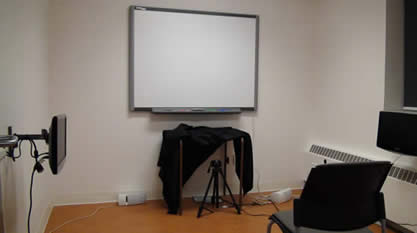
Once everyone is ready, we will take you and your baby into the adjoining testing room. Any other children you’ve brought with you will get to stay in the reception area down the hall and continue to play with a research assistant or graduate student.
The time in the testing room is generally between 3 and 7 minutes. Your baby will be seated on your lap for the entire time, and s/he will be facing forwards, watching one or more images on a television screen. You will be wearing sound-cancelling earphones in order to make sure you don’t inadvertently influence your baby.
In our studies, we measure babies’ looking time at the television screen: boredom, and a corresponding decrease in looking time, indicates learning.
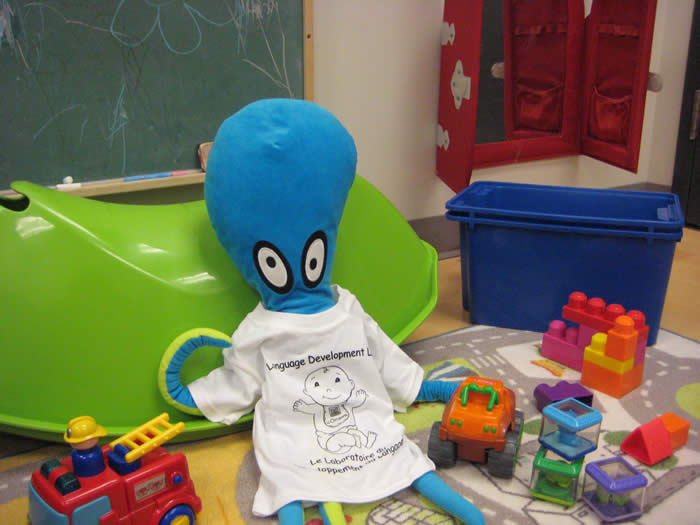
After the testing is completed, we will go back into the reception room, at which point we often have one or two language questionnaires that we will ask you to fill out, depending on the study. We’ll also be happy to answer any questions you may have on language development in general. Then, before you go, we’ll give you and your baby a thank-you gift for participating in our study. A lab member will then walk you back to your car/bus stop/teleportation device. Thus ends your visit to the Language Development Lab.
FAQ
What are some examples of the research you do at the Language Development Lab?
For a synopsis of studies currently in progress at the LDL, please click here.
What does a visit to the lab involve?
Our studies take place at the University of Ottawa in a cozy, welcoming environment. You will be welcomed in our bright reception room, which has lots of toys for your baby, and any older siblings, to play with. We will explain the specific study to you in detail and will be happy to answer any questions you may have. Our actual studies take place in another room down the hall from the reception area. Your infant will be seated comfortably on your lap, watching pictures on a monitor while listening to words or sounds. We videotape your infant’s looking times to the monitor, which tells us what they think about the sounds or words being played. After the study, we ask you to fill out a questionnaire about the words your baby currently knows. Please click here to take a virtual visit to the lab.
What does an online visit involve?
Online activities are held over Zoom. When you join the Zoom call, you will be greeted by a research assistant that will conduct the session with you and your child. We will then share our screen and begin to present the activity. Participation generally takes between 30-45 minutes.
How long does a session last?
A visit to our lab generally takes about half an hour from start to finish, but the time in the actual testing room is usually between 3 and 10 minutes. Our studies almost always involve just one visit to the lab, although babies can participate in more than one study if parents would like to do so.
When can sessions be scheduled for?
We are very flexible, and can schedule for whenever is convenient. Evenings and weekends are usually okay too, if that’s what is best for you.
Do I get any compensation for participation?
We have a special gift for all our participants. Also, we’d love to answer any questions that you might have about language development!
Can I bring any of my other children with me to the lab?
For sure. A research assistant or graduate student will watch your child(ren) in the reception room (where there are lots of toys to play with) while you are with your baby in the testing room. Just make sure to let us know ahead of time if you plan on bringing other children with you.
What do you do with my child’s results?
Your baby’s individual performance is not evaluated. This is because we are interested in babies’ performance as a group. For instance, we may be interested in how 14-month-olds differ from 17-month-olds in their ability to use language sounds in words. After we complete a study, we present it at developmental psychology conferences and publish it in various academic journals. Also, we will mail you the results of the study in which your baby participated.
What is your policy on confidentiality?
The personal information we collect is never released to any third party. In records of our studies, babies are identified only by subject number. Data are accessible only by members of the language development lab, and are destroyed after ten years time.
What about ethics?
All of our studies are approved by the ethics board of the University of Ottawa.
Where are you located?
We are located at the University of Ottawa's Main campus, in the Vanier building. Directions to our lab, as well as a link to a map.
How do I sign up to participate?
If you are interested in participating, you can give us a call at 613-562-5800 ext. 4447, or you can fill out an online submission form here. Then, when your child becomes eligible for one of our studies, we will contact you and provide you with the details of the study. At that point, you can decide whether or not you would like to participate in that particular study.
Media and Events
May 2016
uOttawa - Register now to attend a Faculty of Social Sciences Lecture on May 2nd by Dr. Fennell who will be discussing the latest discoveries in the field of infant bilingualism.
June 2014
Ottawa Citizen - Babies can detect subtle differences in accent, affecting their ability to learn new words
Canadian Family - Dr. Fennell is featured in this article about how to raise a bilingual child.
Radio Canada - Dr. Fennell's study shows that exposure to more than one language in fact does not impair language learning.
September 2010
Gazette - Just a few months and old and already bilingual.
March 2010
TFO PANORAMA - In this interview, Dr. Fennell talks about bilingualism and demonstrates how studies with infants are conducted at the Language Development Lab. Please note that this is a French language program.
October 2007
New Scientist - Fennell thinks the demands of learning two languages mean babies don’t notice differences until later.
Directions
From downtown:
- Take the Laurier Street Bridge east over the Rideau Canal (past the Department of National Defence).
- Turn right (south) on King Edward.
- Turn right onto Thomas More Private. The entrance to the garage will be located on your left.
- We will meet you at the entrance to the garage to give you access to the garage.
From the West on the Queensway:
- Take the Nicholas off ramp (Exit 118) and continue to Lees Ave. Continue to King Edward.
- Turn left onto Thomas More Private. The entrance to the garage will be located on your left.
- We will meet you at the entrance to the garage to give you access to the garage.
From the East on the Queensway:
- Take the Nicholas off ramp (Exit 118) towards Mann Avenue. Continue to King Edward.
- Turn left onto Thomas More Private. The entrance to the garage will be located on your left.
- We will meet you at the entrance to the garage to give you access to the garage.
By Bus arriving at Laurier Station:
- Get off at Laurier Station and walk towards Desmarais building (55 Laurier avenue East, Building Code DMS) main entrance and walk through two sets of glass windows
Director
Dr. Christopher T. Fennell is an Associate Professor in the School of Psychology at the University of Ottawa.
Dr. Fennell completed his Bachelor of Arts (Honours) in Psychology at the University of New Brunswick in 1998. He then jumped coasts and did both his Masters and Doctoral degrees at the University of British Columbia, under the supervision of Dr. Janet F. Werker, FRSC. The focus of his Masters work was examining how infants being raised in two languages apply speech perception skills to early word learning. For his doctoral work, Dr. Fennell investigated the circumstances under which early word learners are able to most efficiently use speech perception to guide word learning.He was awarded the Dissertation Award from the International Society for Infant Studies for this research.
Dr. Fennell then completed post-doctoral studies with Dr. Sandra R. Waxman at Northwestern University in Evanston, IL, USA. The focus of his research with Dr. Waxman was examining infants' use of sound detail in new words presented in sentences, where infants can use the syntax to clearly establish the target words' identities as object labels.
He began his career at the University of Ottawa in January 2006.
Lab Coordinator
Patrice Yazdanyar

Phone: 613-562-5800 ext. 4475
Email: ldl@uottawa.ca
Graduate Students
- Julia Guerra
- Jean-Louis Rene
- Carmel Tshila N'Sa
- Chiamaka Okigbo
Honours Thesis Students
- Emily Alexander
- Elisa Loftus
Research Assitant
- Shirley Liu
Volunteers
- Simona Cepoi
- Kate Fitzgerald
- Maria Bolano Valle
- Laila Reni Fuoco
- Isabel Celine Ghiara
Former Members of the Lab
- Rand Al-Houssan (Honours Thesis)
- Caitlin Atkinson (Research Assistant)
- Melanie Borch (Honours Thesis)
- Katie Cassidy (Research Assistant)
- Alia Chamberlain (Honours Thesis)
- Will Deller (Honours Thesis)
- Audrey-Ann Deneault (Research Assistant)
- Thyra Driver (Research Assistant)
- Annie Drouin (Ph.D Student)
- Brock Ferguson (Honours Thesis)
- Inès Fiedler (Research Assistant)
- Christine Frank (Research Assistant)
- Becky Ginsburg (Research Assistant)
- Sophie Godbout-Beaulieu (Graduate Student)
- Alexia Gravel (Research Assistant)
- Roxane Gregoire (Honours Thesis)
- Matthew Hoftyzer (Honours Thesis)
- Tamara Hudon (Ph.D Student)
- Emily Kuurstra (Honours Thesis)
- Corinne Laliberté (Research Assistant)
- Maude LeBouthillier-Shaugnessy (Honours Thesis)
- Angélica Martinez-Cepeda (Honours Thesis)
- Stéphanie Monette (Honours Thesis)
- Christine Moreau (Honours Thesis)
- Monika Nazair (Honours Thesis)
- Bianca Paluche (Honours Thesis)
- Noreen Rahmani (Research Assistant)
- Cloudia Rodriguez (Research Assistant)
- Francesca Rosina-Talarico (Honours Thesis)
- Allyson Lim Tharamarajah (Research Assistant)
- Angleline Tsui (Ph.D Student)
- Robert Udala (Honours Thesis)
- Katrie Williams (Honours Thesis)
- Amélie Bernard (Post-Doctoral Student)
- Marie-Hélène Drolet (Post-Doctoral Student)
- Jean-Phylippe Provencher (Post-Doctoral Student)
- Emma Moores (Honours Thesis)
- Margarethe McDonald (Post-Doctoral Student)
For Students
Students interested in volunteering, completing an honours thesis project, or graduate studies at the Language Development Lab should contact the lab's director, Dr. Christopher Fennell. Interested honours thesis students should contact him in the fall or winter semester of their third year. The best time to contact him for volunteering positions would be in the months of August and April to volunteer for the Fall/Winter semesters and Summer semester, respectively.
Dr. Christopher Fennell is currently accepting graduate students in Experimental Psychology. If you are interested please contact him directly.
Please include your contact information as well as an updated CV.
Current Projects
Speaker Identity
Baby Noise
This study involves having you and your child come to the University of Ottawa campus to complete the task described above. You will also be asked to fill out three questionnaires regarding general demographics, and your baby’s language knowledge and language exposure. The study takes approximately 45 min to complete. Free parking or bus fare is provided, and your child will get a small prize at the end of the study!
*** Please note that this study is currently only offered in English and your child must be able to understand English***
Learning their First Words: how much detail do babies pay attention to?
The first steps are always the hardest: for beginners, word-learning is a very challenging task. To know that “ball” refers to the round bouncy thing that is great fun to drop and then make someone else pick up, you have to remember (i) the sound of the word (b-a-l), (ii) what the object looks like (round, bouncy, great fun…), and (iii) the crucial fact that the sound form of the word and the visual form of the object go together (this is what is referred to as associative word learning).
Because associative word learning is so complex, at first babies may not pay attention to all the details in the sound of the word. We are interested in studying exactly how much detail babies use or don't use when learning their early words, and how this use of detail develops over time. Also, we are trying to see if there are ways that we can make associative word-learning easier for babies.
Learning new words, but can we prove it?
We know that infants as young as 6 months old can understand some words in everyday situations, but this has been difficult to demonstrate in research settings. In this study we will present infants with words that they may know already; they will hear the word played while watching the corresponding image on a screen. We will then present new, nonsense words with corresponding novel images to see whether they can associate the word they are hearing with the image they are seeing. If infants recognize the novel word, then we expect them to look at the correct image on the screen when presented with more than one image at once. We are testing whether infants will learn these words earlier when they are presented in sentences instead of in isolation (e.g. "Look at the bottle!" versus "Bottle!"), as the former case is more similar to the speech they hear every day. Preliminary results of this study were presented at Development Conference in May 2014. Thank you to everyone who has participated so far!
The effect of mixed-up labels on word-learning
Previous work has demonstrated that a brief training period with familiar word-object pairings (e.g. seeing a shoe and hearing “shoe”) will help infants to subsequently learn a completely new word-object pairing. In our study, we will present three familiar objects but will mix up their names (e.g., they will see a shoe, but hear “kitty”). We would like to see whether this “mixed up” training phase will help or hinder infants’ abilities to learn new words in detail. If it hinders these abilities, this would be good evidence that babies tap into their knowledge that nouns go with objects, and not that any pre-exposure to words and objects will enhance word learning. Thank you to all who have participated in this study so far!
Using words to form categories
Research has shown that hearing a word in either a familiar or an unfamiliar language while seeing an object on-screen can help 3-6-month-olds categorize objects, but hearing a non-linguistic sound does not have this effect. As of yet, only monolingual infants have been tested, so we would like to see how bilingual infants perform in comparison. In this study, we show infants many examples of an object on a screen (for example, many differenttypes of cars, one at a time). Once they get bored of this, we show them a member of the category (such as a car) and another type of object (such as a boat) to see whether babies understand that a new car, as opposed to another type of vehicle, belongs to the category “car.” Testing for this study began in March 2014!
Understanding Bilingual and Monolingual Language Acquisition via Brain Waves
Previous research has shown that bilingual babies may have a harder time distinguishing similar phonemes and similar sounding words at an age where monolinguals can. One hypothesis to explain this is that there may be a slight delay in bilinguals because they are experiencing a variety of input (including different accents and pronunciations of words). Another hypothesis is that bilinguals actually have no problem at all discriminating sounds and words, but that there was a problem with how researchers tested them. Previous methods have relied on infants being surprised by a sound or word change and looking longer; however, slight changes in words may not be surprising for bilinguals given their variable sound and word environment (e.g., Dad says “Le bébé” and Mom says “Baby”). In this study, we will be testing 7- to 9- month old monolingual and bilingual infants. Monolingual babies serve as the basis of comparison to bilingual babies. We will be looking at their ability to discriminate vowel contrasts, such as the difference between bait and boot. To do so, we will use the event-related potential technique (ERP), which has been widely used to examine brain activity and it is a well-established technique to study infant language development. It is non-invasive and completely safe. We will first place a cap on your baby’s head. This cap has small discs that measure the electrical activity in your baby’s brain. It does this by picking up the electrical fields emitting from your baby’s scalp. This is completely non-invasive. We will squeeze some gel, like the gel used for ultrasounds, onto the discs so that they make contact with the scalp. Your baby will sit in your lap during this whole process. We will then go in to the testing room. The cap will be plugged in to a computer that will record your baby’s brain activity, millisecond by millisecond. She/he will be sitting in a high chair and you will be sitting right behind him/her. An experimenter will be in the room with you helping entertain your baby while she/he watched a silent video. While the video is playing, she/he will hear a sequence a vowels. Most of the vowels will be the same (e.g., /e/), but your baby will randomly hear a different vowel from time to time (e.g., /u.). If your baby can detect the difference between the vowels, their brain emits a unique electrical pattern. We will examine your baby’s brain waves after the experiment to see if that pattern is present. After the study, we will return to the main room and slip off the cap. There may be some gel remaining on your baby’s head. We will provide you with baby wipes and baby shampoo to clean the gel. We will be happy to help you do this, if you wish.
How do infants learn two languages and is it related to their cognitive skills?
One of the first steps of learning words in infancy is to parse out individual words from fluent speech. This proves to be a difficult task, as speech contains no consistent cues to indicate individual words (e.g. no reliable pauses between words). Previous studies suggest that infants can overcome this challenge by tracking natural regularities in their language. For example, infants are shown to be able to track how sounds and syllables co-occur in fluent speech. Based on the co-occurrences, infants find the underlying structure of their language and use this structure to identify individual words. However, all previous work focused on how infants find individual words in one single language. With the emphasis of bilingualism in the capital, it is essential for us to investigate how babies learn two languages simultaneously from fluent continuous speech. In this study, we aim to fill in this knowledge gap by investigating how monolingual and bilingual babies track two new languages in a research setting. Infants will be presented with two artificial languages that are mixed together and they will be tested on their ability to identify words from each language. In addition, we will examine whether babies’ capacity to successfully identify words in each language is related to certain cognitive skills. Thus, in the second half of the study, we will test infants’ cognitive skills by measuring the time required to switch their attention to two different visual locations. We expect that infants’ cognitive skills will be related to their ability to learn two new languages simultaneously because both tasks require infants to be able to switch attention between two inputs. This study involves two lab visits within two week(s). Each lab visit will last around 30 to 40 min and all appointments will be booked at parents’ convenience.
We are looking for infants (ages 4 to 20 months), and their parents to participate in our language studies. We welcome all infants, whether they are learning one language at home or more!
If our research interests you, and you would like to participate in a study, please click on the button below.
Alternatively, call us at (613) 562-5800, ext. 4447, or email us at ldl@uottawa.ca:
All personal and contact information is confidential and will not be shared with any 3rd party. It is only for use in the Language Development Lab at the University of Ottawa.

.jpg?width=222&height=252&name=PXL_20221105_204611979.MP-EDIT%20(1).jpg)


